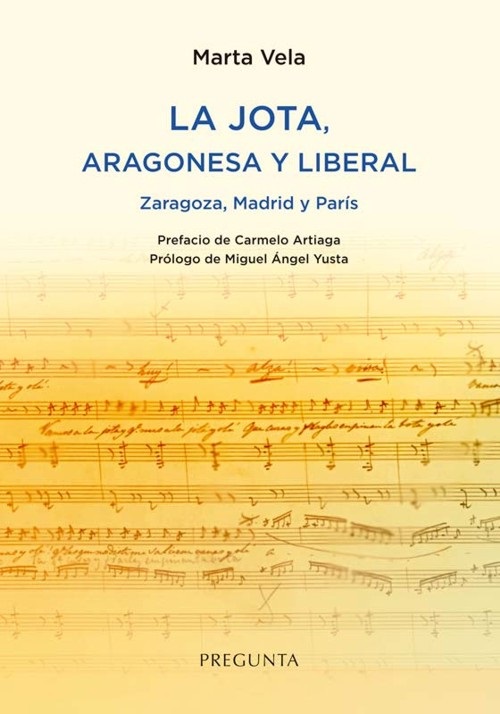- Books
- 28 de May de 2024
- No Comment
- 8 minutes read
La jota, aragonesa y liberal. Zaragona, Madrid y París

La jota, aragonesa y liberal. Zaragona, Madrid y París


Alberto Menjón
Aragonese Jota1 and liberal democracy
We are witnessing today that every war is also cultural, and that every era reflects a unique relationship between the political nature of human beings and their capacity to influence art, and vice versa. In this context, La jota, aragonesa y liberal by Marta Vela (Pregunta y Gobierno de Aragón, 2024), a continuation of La jota, aragonesa y cosmopolita (Pregunta y Gobierno de Aragón, 2022), immerses us in the turbulent world of revolutions and pronouncements aimed at securing citizens’ rights within the framework of the emerging liberal democracy of the nineteenth century. This work supports the candidature of the Jota as a UNESCO Intangible Cultural Heritage of Humanity, with contributions from other researchers such as Gonzalo Preciado-Aranza (Breve historia de la jota aragonesa en el ballet, Rolde de estudios aragoneses, 2023).
A myriad of artists parade through the pages of the author, including George Sand, Chopin, Zorrilla, Delacroix, Espronceda, Bretón, Sarasate, and Falla, who play supporting roles to the three protagonists of the story: Florencio Lahoz, an Aragonese musician based in Madrid and the primary responsible for the Jota international dissemination; Sebastián Iradier, a renowned composer of habaneras; and Pauline Viardot-García, an international prima donna and sister of the unfortunate Malibran. These three figures were committed to the liberal ideology of their time through music.
Through finely interwoven fragments, the story begins with a vivid fresco of the Cinco de Marzo of 1838 – known as Cincomarzada2, one of the first secular holidays in Spain – tracing the vicissitudes of the 19th century during the reign of Isabel II and the Second Empire in France. It starts with the arrival in Madrid of two newcomers, provincial organists Iradier from Álava and Lahoz from Zaragoza, at the beginning of the tumultuous Elizabethan period when the arts guild was a fundamental support for María Cristina’s aspirations for her daughter’s future reign. Even then, in 1839, the prestigious Revue et Gazette musicale de Paris recognized the libertarian nature of the Aragonese jota and its struggle against obscurantism: “together with the jota and the seguidilla, songs and dance airs at the same time, the civil disorders of this century have given birth to some songs that could be called political. The most famous of all is el Himno de Riego (Riego’s Hymn)” (p. 71).
This assertion was not unfounded, given that the text of what was the national anthem during the so-called Trienio Liberal (1820-1823) was recreated in various popular songs, including the Aragonese jota, a great success in the capital since the premiere of the comedy La pata de cabra (The Goat’s Leg):
Hymn of Riego (Gomis? 1820)
Soldiers, the homeland
calls us to fight,
let us swear for her sake
to triumph or to die.
Jota de las avellanas (Iradier, 1840)
A la jota viva la Reyna Isabel,
juremos por ella morir o vencer.
A la jota jota de las avellanas,
que las que me diste me salieron vanas.
(possible translation, as there’s no official one)
A la jota long live the Queen Isabel,
let us swear by it to die or to win.
A la jota jota of the hazelnuts,
that the ones you gave me came to me in vain.
Meanwhile, Lahoz continued in Madrid, riding the wave of success with his jota, the most famous of all his works, which would later merit Galdós‘ commentary near the end of the Episodios Nacionales:
3“The budding maestros, like Oudrid, used to join the enthusiastic chorus of the musical gang, whether at Amato’s narrow café or at the Príncipe or the Lhardy patisserie, as did the youngest of the Italian tenors of the Circus company, Enrique Tamberlick, who that year had made his debut with Parisina d’Este. Private concerts at Soriano Fuertes’s house brought friendships closer, inflamed and exalted the faith of the musical religion: there Oudrid, an excellent pianist, gave the first performances of the Jota aragonesa with variations and the Fantasia on motifs by Maria di Rohan (pp. 101-102).”
The book concludes on the eve of the First World War, with two Parisian jotas, “La Jota de Pablo de Sarasate” and the “Jota aragonesa de las Siete canciones populares españolas de Falla”, capturing the anguish of the war’s onset in Paris.
In this way, the founding values of democracy are reflected in the cosmopolitan culture, where Aragonese jota and Italian opera formed a common front in the pursuit of freedoms that were ultimately swept away by the torrent of the First World War “like the fury of the River Ebro that sweeps away everything in its path” (p. 235).
___
1 The Jota is a traditional Aragonese dance that is a vibrant and integral part of the cultural heritage of the Aragon region in Spain.
2 The Cincomarzada is a festival celebrated on the 5th of March in the city of Zaragoza, located in the region of Aragón, Spain. It commemorates the victory of the citizens of Zaragoza over the Carlist army during the First Carlist War in 1838.
3 Free translation, as there appears to be no complete English translation available specifically for Bodas Reales, one of the novels from Benito Pérez Galdós’s Episodios Nacionales series, to which this fragment belongs.
Title: La jota, aragonesa y liberal: Zaragoza, Madrid and Paris
Author: Marta Vela
ISBN: 9788419766373
Publisher: Ediciones Pregunta
Language: Spanish
Number of Pages: 246 pages
Publication Date: March 2024
References:
Vela, M. (2024). La jota, aragonesa y liberal: Zaragoza, Madrid y París. Zaragoza: Ediciones Pregunta. https://preguntaediciones.com/libro/la-jota-aragonesa-y-liberal/
Preciado-Aranza, G. (2023). Breve historia de la jota aragonesa en el ballet. Zaragoza: Rolde de estudios aragoneses. https://www.roldedeestudiosaragoneses.org/novedad-breve-historia-de-la-jota-aragonesa-en-el-ballet
Source: educational EVIDENCE
Rights: Creative Commons

